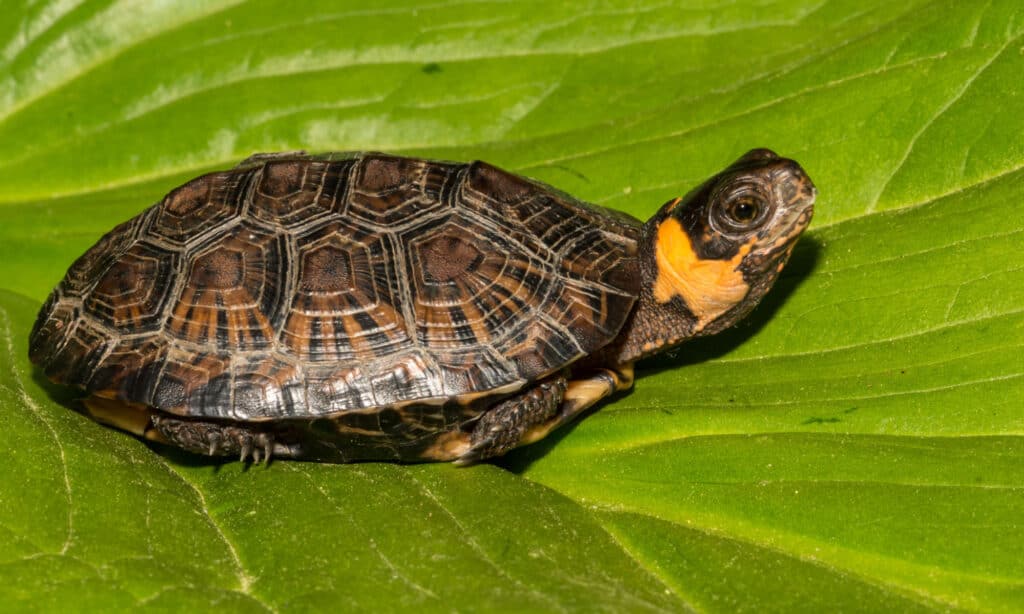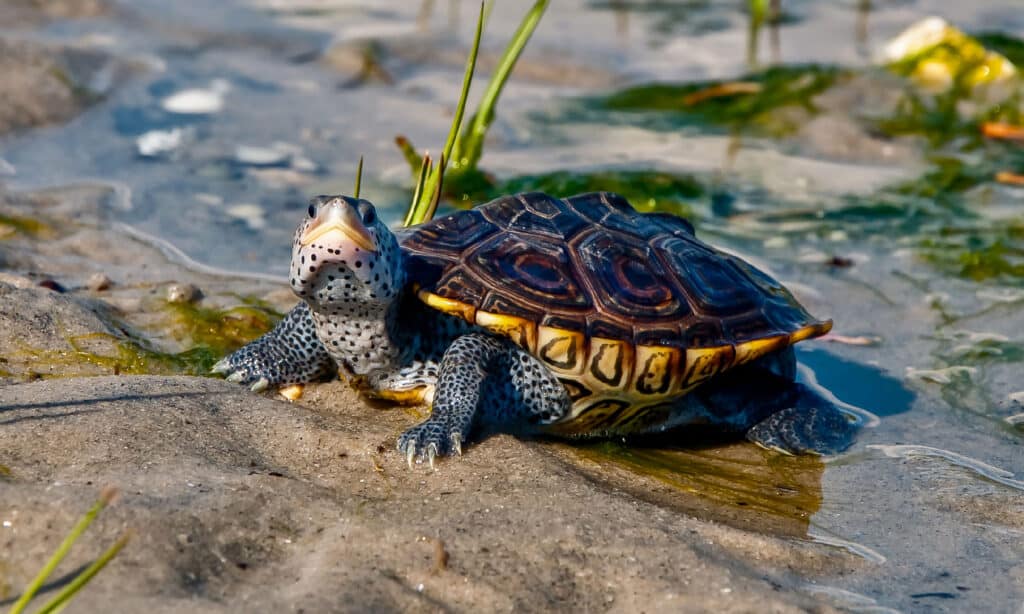Despite being such a small state with a fairly chilly climate, New Jersey is home to more than a dozen different species of turtles! From teeny-tiny bog turtles to impressively large redbelly and snapping turtles, the Garden State’s shelled reptiles are varied and unique. Below, we’ll take a closer look at 7 of New Jersey’s most interesting turtles and where you can find them in the wild.
1. Bog Turtle (Glyptemys muhlenbergii)

Bog turtles are critically endangered due to habitat loss.
©Jay Ondreicka/Shutterstock.com
Averaging a mere 3 to 4 inches in length, the bog turtle is one of New Jersey’s tiniest reptiles. Its small, oval-shaped carapace is typically dark grey to dark brown. Each individual scute on its shell has a handsomely mottled pattern. Its skin is mostly brown, but on the sides of the turtle’s head are bright orange markings.
Sadly, because it is critically endangered, the bog turtle is one of the least common turtles in the Garden State. Habitat loss has caused the bog turtle’s numbers to dwindle. However, if you’re lucky enough to spot one, you’ll likely find it in or near a slow-moving or still body of water like a pond, marsh, or slow-moving stream. It prefers having lots of plant cover and vegetation to hide from predators.
Bog turtles are most active in the spring and summer. They can be found throughout New Jersey as well as much of the eastern United States, though their numbers have been declining in New Jersey in particular for many years.
2. Spotted Turtle (Clemmys guttata)

The spotted turtle’s dark brown carapace is accented by many tiny yellow spots.
©iStock.com/JasonOndreicka
True to its name, the spotted turtle’s dark brownish-grey carapace and skin are both covered in tiny bright yellow speckles. It’s currently the only species in its genus, Clemmys, and is semi-aquatic.
Also quite small, spotted turtles average a mere 3 to 5 inches in length. Its spots tend to fade with age, with hatchlings having the brightest yellow markings. Females of the species have flatter plastrons and shorter tails than males. The plastron and underside of the turtle’s body are more vibrant and typically yellow or orange.
Mainly active in the spring, spotted turtles are most commonly present in shallow, slow-moving bodies of freshwater like ponds, swamps, marshes, bogs, and streams with muddy bottoms. They live throughout the state of New Jersey and along much of North America’s eastern coastline.
3. Common Snapping Turtle (Chelydra serpentina)

Because they spend so much time underwater, it is common for snapping turtles’ shells to be covered in a layer of algae.
©Patrick Rolands/Shutterstock.com
The common snapping turtle has colonized nearly every state in America, including states as far north as New Jersey! It’s Garden State’s largest native turtle and is one of the largest freshwater turtles in the world. It gets its scientific name from its long, flexible, serpentine neck. Though it resembles the alligator snapping turtle, the two species are not closely related.
Ranging from around 8 to 20 inches long, the common snapping turtle is both long and quite heavy. Fully-grown snapping turtles commonly weigh anywhere from 20 to more than 80 pounds. Their shells are thick and quite textured and range in color from greyish brown to an olive green shade. They have large, wide heads and sharp beaks to tear into their insect, fish, crustacean, mollusk, and amphibian prey.
In New Jersey, the common snapping turtle is most active in the spring and summer. It lives throughout the entire state in various bodies of water and habitats and can even tolerate brackish water. Its geographic range covers much of the American Midwest and the eastern half of the country.
4. Northern Diamondback Terrapin (Malaclemys terrapin terrapin)

The diamondback terrapin’s black and white spotted skin and beautifully patterned carapace give it a distinctly vibrant appearance.
©iStock.com/JasonOndreicka
The northern diamondback terrapin is certainly one of New Jersey’s most visually stunning turtles by far! Its carapace is typically brown and off-white or yellowish with a distinctly ringed pattern on each individual scute. The turtle’s skin is usually light grey or cream-colored with mottled dark grey and black markings, giving it a striking appearance even from a distance.
This species is average in size, ranging from around 4 to 9 inches long. Females are longer and heavier than males. While the turtle’s carapace is dark in color, the underside, the plastron, is lighter and ranges from yellow to orange. The species is highly aquatic, with webbed and clawed feet.
The northern diamondback terrapin’s geographic range consists mainly of coastal regions along the eastern half of the United States. Unlike most of America’s turtle species, this turtle tolerates brackish water very well. In New Jersey, it mainly lives along the state’s eastern coast in saltwater marshes and estuaries.
5. Wood Turtle (Glyptemys insculpta)

The wood turtle has a rugged, textured carapace.
©Jay Ondreicka/Shutterstock.com
The wood turtle is closely related to the aforementioned bog turtle. The two species are both members of the Glyptemys genus–in fact, they’re currently the only two members of the group! The species’ scientific name, insculpta, refers to the sculpted, textured appearance of its carapace.
Ranging from 4 to 9 inches long, the wood turtle is average in size and build. Their rugged, uneven carapace is typically dark brown or greyish-brown in color, while its plastron and much of the underside of its skin are yellowish-orange. Males of the species are slightly larger than females and have larger heads and claws as well as longer tails. It resembles the eastern box turtle and also shares a similar geographic range.
Wood turtles are most active in New Jersey in the spring and summer months ranging from March through October. They prefer wetland habitats with lots of vegetation and live throughout northern New Jersey and much of the American Northeast.
6. Northern Redbelly Turtle (Pseudemys rubriventris)

The redbelly cooter typically has a dark reddish carapace and an orange plastron.
©iStock.com/passion4nature
Also known as the northern redbelly cooter, this species is best known for its uniquely colorful shell. Both its carapace and plastron have a reddish coloration throughout. The carapace is a darker reddish-brown, while the turtle’s underside is a lighter yellowish-orange.
The northern redbelly is fairly large as far as other similar semi-aquatic species go. It typically reaches 10 to 12 inches long when fully grown, though females can grow up to 15 inches long. Its skin is primarily dark grey with thin yellow stripes.
Notably, this species is threatened in New Jersey due to habitat loss and competition with the invasive red-eared slider for food and shelter. It is most active in the late summer months, from June through August. Its preferred habitats are small bodies of freshwater like ponds, rivers, and slow-moving streams. Interestingly, this pond turtle can also tolerate slightly brackish water.
7. Common Musk Turtle (Sternotherus odoratus)

Small yet equipped with a foul-smelling defense mechanism, the musk turtle should be admired from a safe distance.
©Ryan M. Bolton/Shutterstock.com
Also lovingly known as the “stinkpot” turtle, the common musk turtle’s most prominent trait is its foul-smelling defense mechanism. The sides of its shell house scent glands that can emit an awful odor meant to deter predators. Despite its small, vulnerable size at just 2.5 to 5.5 inches long, this unique reptile can defend itself quite well with its icky scent glands.
You can easily identify this turtle by its dark greyish-brown dome-shaped carapace. Its skin is similarly dark brown but has thin yellow stripes, most prominently along the sides of the turtle’s head. Its snout is short and pointed, and its feet are fairly large and webbed. Interestingly, its tongue has lots of tiny, round nubs that allow the turtle to breathe underwater for short periods of time.
In terms of preferred habitats, the stinkpot turtle is highly aquatic and often resides in shallow ponds, slow-moving streams, and lakes with lots of vegetation and muddy bottoms. You can find musk turtles throughout much of the eastern half of the United States. In New Jersey, the turtles populate virtually the entire state.
Up Next:
- Are Turtles Reptiles or Amphibians?
- What Turtles Live in (and Near) the Mississippi River?
- 10 Turtles in Georgia
The photo featured at the top of this post is © iStock.com/JasonOndreicka
Thank you for reading! Have some feedback for us? Contact the AZ Animals editorial team.






